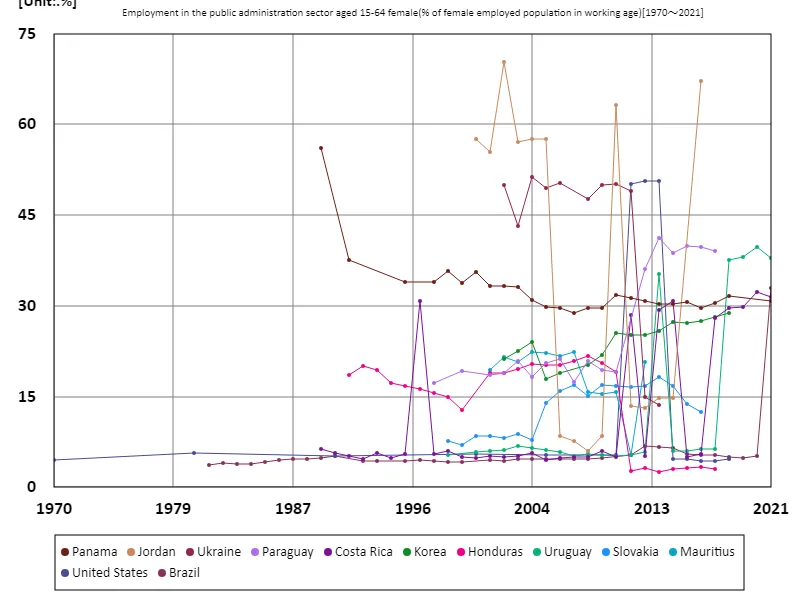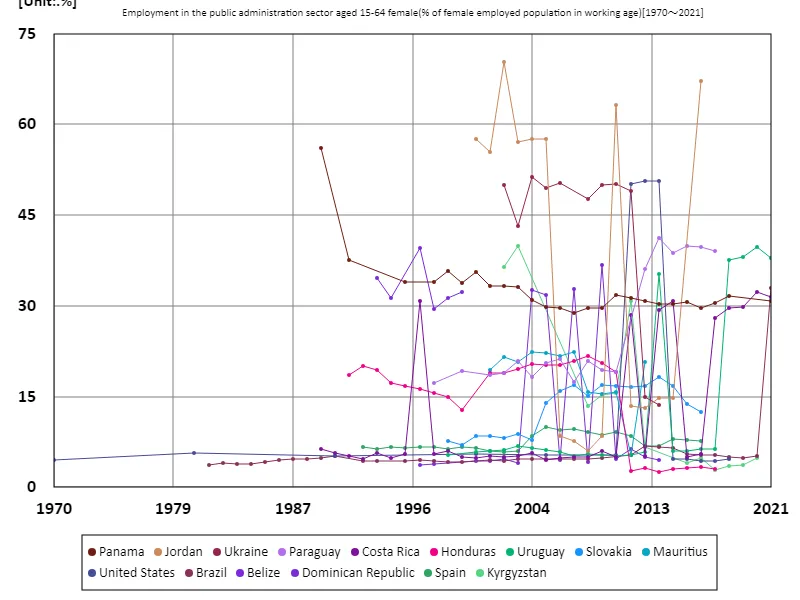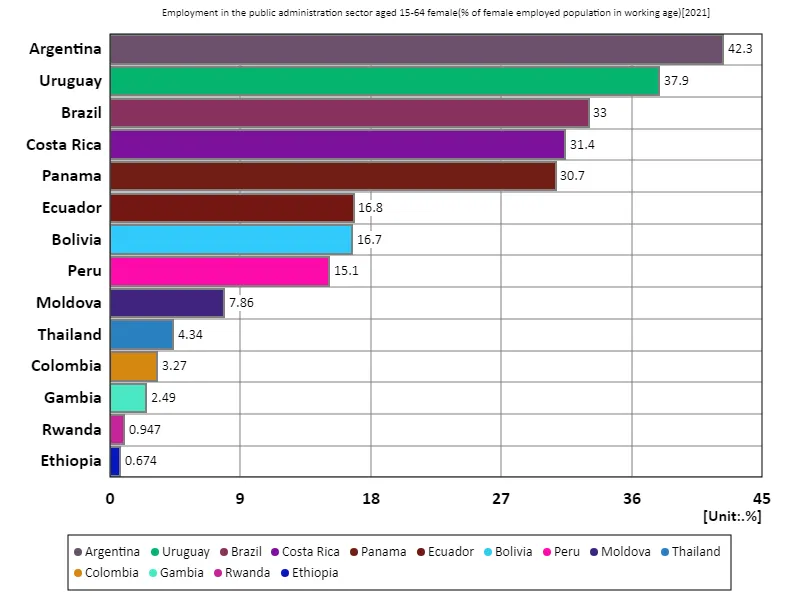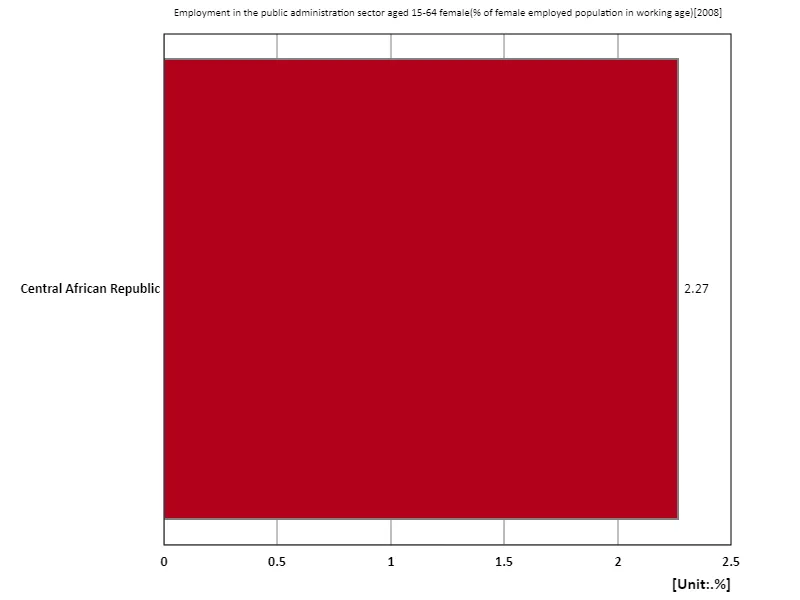- Abstract
- Employment rate in the public administration sector for women aged 15-64 (percentage of working-age women in the workforce)
- Employment rate in the public administration sector for women aged 15-64 (percentage of working-age female employment population) (Worldwide)
- Employment rate in the public administration sector for women aged 15-64 (percentage of working-age female employment in the labour force) (Worldwide, latest year)
- Employment rate in the public administration sector for women aged 15-64 (percentage of working-age female employment in the labour force) (region, latest year)
- Reference
Abstract
Uruguay has the highest employment rate in the public administration sector for women aged 15-64 at 37.9% in 2021, highlighting that female employment in the public sector is particularly notable. This suggests that Uruguay’s public sector may employ a relatively large number of women and provide stable employment opportunities regardless of gender. Historically, the public sector has generally offered stable employment and played a role in promoting gender equality. Furthermore, public sector employment is often a key driver of women’s labor market participation in Latin American countries compared to developed countries. Uruguay’s high employment rate reflects women’s active participation in the public sector and comparing it with data from other countries helps to better understand regional differences in employment opportunities and the impact of policies.
Employment rate in the public administration sector for women aged 15-64 (percentage of working-age women in the workforce)
Jordan’s public administration employment rate of 70.3% for women aged 15-64 in 2002 indicates high female participation in the public sector during the same period. This peak suggests that policies and social factors at the time may have strongly encouraged women to participate in the public sector. However, the current figure of 95.5% is actually well below the peak figure at that time, and this is thought to be due to a variety of factors. For example, fewer public sector employment opportunities, policy changes, or new barriers to women’s labor market participation may have played a role. Overall, while there was a temporary increase in female employment in the public sector, the subsequent decline may reflect changes in the country’s economic situation or labor market, or the effects of government employment policies. This data allows us to dig deeper into the historical evolution of women’s employment in the public administration sector and how policy changes are impacting it.


The maximum is 70.3%[2002] of Jordan, and the current value is about 95.5%
Employment rate in the public administration sector for women aged 15-64 (percentage of working-age female employment population) (Worldwide)
The employment rate of women aged 15-64 in the public administration sector in Jordan reached a very high level of 70.3% in 2002, but at first glance the current figure of 95.5% appears to be a decline from the peak. However, the 95.5% figure here is a ”relative” figure to the peak of 70.3% and actually represents a significantly higher employment rate than was the case then. This demonstrates that Jordan’s public administration sector continues to make great strides in promoting women’s employment. Looking back at historical data, the 2002 peak may have been a period when certain policies or societal changes were effective, but sustained high employment rates since then show that women’s roles in the public sector are well established. Overall, it can be said that Jordan has made long-term progress in promoting public sector employment for women and providing stable employment opportunities.


The maximum is 70.3%[2002] of Jordan, and the current value is about 95.5%
Employment rate in the public administration sector for women aged 15-64 (percentage of working-age female employment in the labour force) (Worldwide, latest year)
According to 2021 data, the employment rate in the public administration sector for women aged 15-64 in Argentina is 42.3%, the highest overall. This high percentage suggests that Argentina is actively promoting female employment in the public sector. On the other hand, the average figure of 17.4% indicates that female employment in the public sector is relatively low in many countries. The combined figure of 244% reflects a relatively high overall combined employment rate, with some countries recording particularly high employment rates. These data reveal international variations in employment opportunities for women in the public administration sector. Countries with high employment rates, such as Argentina, are characterised by their active promotion of women’s roles in the public sector and their commitment to social equality. Meanwhile, countries with low scores need to develop policies and initiatives to further promote women’s participation in the public sector.


The maximum is 42.3% of Argentina, the average is 17.4%, and the total is 244%
Employment rate in the public administration sector for women aged 15-64 (percentage of working-age female employment in the labour force) (region, latest year)
Data from 2008 show that the overall employment rate in the public administration sector for women aged 15-64 is uniformly 2.27%. This indicates that employment of women in the public sector is at an extremely low level, and the fact that this figure is for the Central African Republic also highlights the limited employment of women in the public administration sector in many countries, including the Central African Republic. This low employment rate may reflect the public sector’s underutilization of the female workforce or a lack of employment opportunities for women. In developing countries and politically and economically unstable regions in particular, public sector employment opportunities are often limited, further reducing female participation. In contrast, while developed countries often have a relatively high rate of female employment in the public sector, overall there are still disparities in employment opportunities for women in the public sector, with significant differences across countries and regions. This data suggests that policies and initiatives aimed at promoting female employment in the public sector remain a challenge for the future.


The maximum is 2.27% of Central African Republic, the average is 2.27%, and the total is 2.27%



Comments